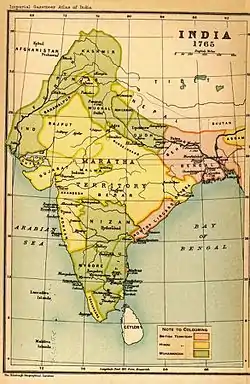| Battle of Delhi, 1764 | |||||||
|---|---|---|---|---|---|---|---|
| Part of Mughal-Jat Wars | |||||||
| |||||||
| Belligerents | |||||||
|
Mercenaries |
| ||||||
| Commanders and leaders | |||||||
|
Supported by |
| ||||||
| Strength | |||||||
|
30,000—35,000 troops[1] 100 cannons[1] 27,000 Sikhs[1] 20,000 Maratha (inactive in battle)[1] |
30,000—35,000 troops[1] Imperial artillery of Delhi[1][2] | ||||||
The Battle of Delhi (1764) was fought between the Jat ruler of Bharatpur and the Mughal rulers of Mughal Empire.[3] Maharaja Jawahar Singh of Bharatpur invaded Delhi and laid siege to stronghold of Red Fort.
Background
On 25 December 1763, Najib-ad Daulah shot Jawahar Singh's father Maharaja Suraj Mal, killing him. Maharaja Sawai Jawahar Singh started preparing to avenge the death of his father.[4]
Battle

Singh marched to Delhi with 60,000 soldiers of his own, 25,000 from Sikhs. Jats plundered 12 colonies of Delhi and finally reached Shahjahanabad Fort, blocking supplies of Najib ad-Dawlah. Saharanpur and other possessions of the Rohilla Chief were plundered by the Jats. The citizens of Delhi came out of the Fort to the Jat camp for corn and other supplies, it was the surrender of the city to the Jats.
After a siege of several months, Najib ad-Dawlah appealed for peace but Singh was determined to take revenge for his father by severing the head of Najib ad-Dawlah. After several days, some Rohilla leaders came to Singh's camp with Zubita Khan who sought the intervention of the Sikhs. They tried to persuade Singh to make peace on the condition that the whole expenditure for war would be repaid by Najib ad-Dawlah.
Singh accepted this offer, partially insistence of his chiefs, including Balram Singh and Mohanram, and returned to Bharatpur along with Lohiya Gate and Ashtadhatu gate which had been brought to Delhi, 461 years ago, by Alauddin Khalji after his Siege of Chittorgarh Fort in 1303. These doors are located in the Lohagarh Fort of Bharatpur.[5][6] In February 1765 a treaty was signed on payment of Rs. 60 Lakhs as war indemnity.
Aftermath
Jawahar Singh returned to his capital but he was enraged towards Holkar for not supporting him in the siege. Jawahar refused to pay the 12 lakhs out of the 22 lakhs promised to Holkar. Jawahar later took his revenge by attacking Holkar's army and defeating the Marathas at Dholpur, which was soonafter conquered.[7]
See also
References
- 1 2 3 4 5 6 7 Sarkar, Sir Jadunath (1971). Fall of the Mughal Empire Vol. 2. M. C. Sarkar. pp. 466–468.
He contracted for the hire of a Maratha army of 20,000 horse for 22 lakhs of rupees...he also engaged 15,000 Sikh mercenaries....Jawahar's own troops were between thirty and thirty-five thousand horse and foot with a hundred pieces of artillery of all calibres and Najibs the same number of men....he had lost faith in his Maratha allies and a Sikh force 12,000 strong appeared near Delhi...at last Jawahar, on 16th February marched away from the city, before the walls of whoch he had spent 160 lakhs of rupees and incurred a further liability of 12 lakhs (due to the marathas) without achieving anything at all.
- ↑ Bhangu, Rattan Singh (1914). Panth Prakash Vol.2 English Translation. p. 665.
- ↑ "Punjabi University. Dept. of Punjab Historical Studies". Proceedings, Volume 20. Publication Bureau, Punjab University. 1987.
- ↑ Misra, S. C. (1981). Sindhia-Holkar Rivalry in Rajasthan. Sundeep Prakashan.
- ↑ Manohar, Dr. Raghvendra Singh (2019). Rajasthan ke Pramukh Durg. Rajasthan Hindi Granth Academy. ISBN 9789388776561.
- ↑ Dubey, Dinanath (2014). Bharat Ke Durg. Publications Division, M/O Information & Broadcasting, Govt. of India. ISBN 9788123018928.
- ↑ Sarkar, Jadunath (2007). The Fall of the Mughal Empire, Vol II. Delhi: Orient Black Swan. pp. 468, 472. ISBN 9788125032458.
The baffled Jat raja retired to his capital, disgusted with Malhar...he refused to pay Malhar the balance of twelve lakhs still due out of the promised 22 lakhs...Jawahar came up with his own troops and 7,000 Sikhs, in his pay and opposed Holkar's men...Following up his victory Jawahar easily captured Dholpur and seized Sultanji and all the other Maratha generals